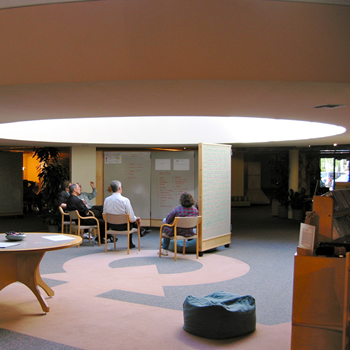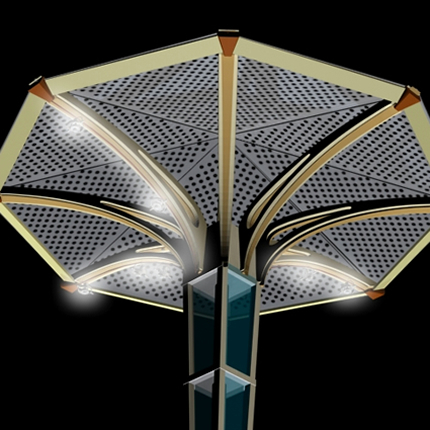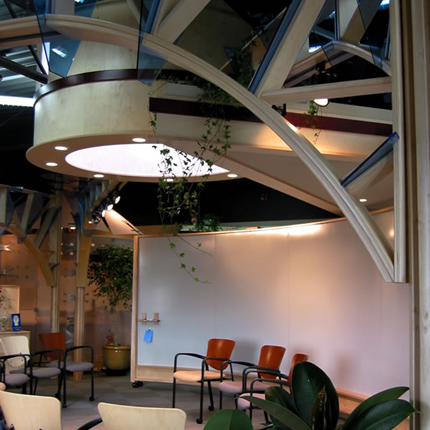the Making, Ownership and Use of navCenters |
click on drawings above for background on the projects illustrated |
how to conceive and realize a new armature for creative work |
| An environment is that which surrounds the circumstances of an organism As a formal system, the 7 Domains Model illustrates those aspects which makeup a full navCenter circumstance. These can be “chunked” into physical environment, work processes and augmentation tooling. |
| In order for a navCenter to function fully and develop its intended purpose it must be a neutral space. It cannot engage in an organization’s food fights for resources. It cannot be seen as an instrument of propaganda. I cannot be captured by part of a power base of an organization, network or political economic region. It cannot be owned by anyone in the conventional understanding of the term. The navCenter is a discipline - a way of working. It is brain-like in its operation: an intelligent nervous system for a complex web of people and organizations. It is a function. It is self-managing and self-evolving stewarded by its own embedded protocols. It does not control an organization or set its agenda. It allows an organization to have control and facilitates the emergence of human right action. |
|
| Our minds come with an operating system which evolves over time, is connected to a world larger than us, and which we partially understand and can learn to engage with and “program.” Our social organizations do not come with this functionality. They are not “wired.” And certainly not connected with a neural net that almost instantly changes automatically with each experience we have. Organizations make up for this lack of connectivity by imposing policies, semi-rigid organizational structures, and often the misuse of technology: a maelstrom of messages with little context, often spinning information, delivered 24/7/365 with overwhelming intensity with virtually no system of documentation at the individual and team level. All this activity just happens with virtually no system integration function. |
| The typical response to the resulting breakdown is more of the same architecture delivered with greater intensity with no understanding that this is a system problem not a human one. Humanity has a requisite variety problem with its own output. |
|
page two using the environment of five |
 |
| The front wall glass folding doors, of the Palo Alto knOwhere store, opened to a patio which extended outward to the sidewalk and inward an equal distance across most of the width of the store. At the center, of the building, a 20 foot diameter opening glass dome rested on the roof over an opening through the second floor enterprise incubation and office hotel spaces to the first floor level. Cool breezes flowed from the front into the entire space and up and out of the dome. Natural light found its way to the working spaces below. Pulling open folding WorkWalls into this 40 foot by 40 foot free space created relaxing work niches. |
|
| There are many kinds of uses and users of a full service navCenter. Each have unique requirements and personal responsibilities. Understanding these roles, and how they make a healthy human ecology, is critical to the proper design and stewardship of a navCenter. |
| navCenters operate nearly 24/7/365. As global connectivity between navCenters increases, I expect most of them will never shut their doors. Already several environments have teamed to facilitate an event with several hundred participants in four locations. This will become common with an idea being “worked around the world” so that when a group reconvenes, after their rest and sleep cycle, they will find their work taken through another iteration of development. A PatchWorks architecture supports this kind of collaboration. Synergy can be had at the scale necessary to dissolve systemic 21st. Century problems. |
| Even given globalization and global issues, all work is local and is done by some one, some team some place. Virtual work is simply the real time connecting of multiple local places. Modern knowledge and design work is difficult - the state of the art of almost every field is highly sophisticated and the competition for mental space intense. Given the complexity of most issues and projects virtually all work is collaborative now. With automation and advanced tooling, the locus of the factory is now the office which is, in its deep architecture, much as it was a hundred years ago with computers replacing clunky typewriters and Star Trek-like communicators instead of those funny looking things which used to sit on your desk. Our workplaces do not meet the requirements of the many different tasks we perform everyday. We are adjusting our work flow and mental modalities to an old model of workplace instead of the workplace adjusting to the work we have to do and with whom, and when we are doing it. The modern knowledge worker-executive-artist-craftsperson-engineer-builder -communicator-performer-financial wizard, never really leaves work nor private life totally behind. Home and workplace are just two expressions of the same thing with a different mix and weight of functions in each. Why then are our homes so inefficient, based on a fading family model that has had at best a 200 year run in a small portion of the world out of 10,000 years of human experience? And, why are our workplaces so sterile? Would you live in a typical office? Would you vacation in one? Is the standard workplace effective? Does it express you, your team and humanity at their best? |
|
|
built 1997 - photo 2002
Palo Alto knOwhere Store
team working under the open dome |
|
 |
| In the modern workplace, nature is mostly delegated a minor and at best symbolic role. I do not know how it is assumed that all of human history and our intrinsic relationship with the earth has gone away in the last century and a half. The knOwhere inside-outside patio formed a transition area between the main collaborative work area of the store and the street forming a foreground-background which worked both ways. With, t1 lines, wireless, objects of art, landscaping, benches, retail goods, banners and umbrellas, it became a lively area that protected and invited at the same time. It made place and was the knOwhere brand. |
|
built 1997 - photo 2002
Palo Alto knOwhere Store
outdoor patio and open doors viewed from bus stop |
|
 |
| The sound of running water, the smells of a real a garden, the quite of a private POD directly off of a gathering place for 400 people. Refuge and prospect, a place of mental rest without risk of losing focus, different worlds within a few steps yet connected by Armature, and a simple pallet of natural materials all within a block long historic 19th Century building re purposed for learning and collaborative design. Creativity and learning require many different mental modes: ways of seeing, feeling, thinking, moving and acting. All the senses are active in recreation, making and innovation. navcenters support and hold these many expressions. |
|
built 2007- photo 2007
UniCredit navCenter Turin
garden, POD, running water off of cllaboration area |
|
 |
| Different tasks require specific technology concentrations with adjustable degrees of visual and sound privacy while still remaining part of a greater environment. This means different kinds of workstations, collaboration spaces and offices are required. It means they have to easily move and reconfigure. It means they have to adjust to individual needs and desires and express individually as well as team and enterprise identity. These values are important everywhere; in a navCenter, given its mission, they are critical and not optional. Remember, a navCenter is a future place where people create their future. |
|
installed 2008- photo 2008
University of Virginia Medical Center
multi-screen media POD for four people |
|
| |
|
| |
| |
|
| |
|
| |
|
| |
|
| |
|
| |
|
| |
|
| |
|
| |
|
| |
|
| |
|
| |
|
| |
|
| |
|
|
|
|
|
your workplace |
right livelihood |
|
|
|
|
|
|
| |
|
|
|
posted:
September 14, 2010 • updated October 2, 2010 • 9:21 PM @Elsewhere • 8% complete |
© Matt Taylor, MG Taylor Corporation, tsmARCHITECTURE, Athenaeum International, all rights reserved
This is intellectual property which constitutes a vested interest in all projects shown
|
|
|








